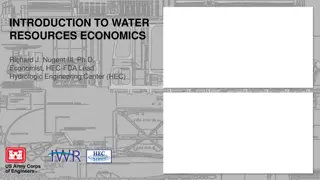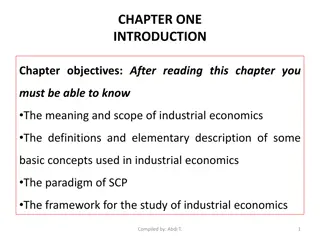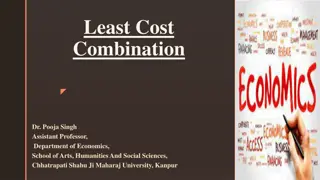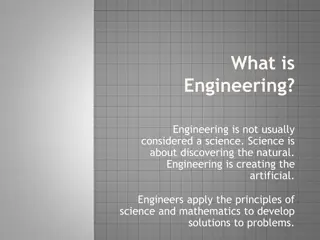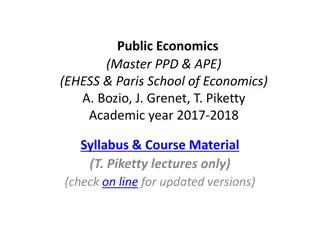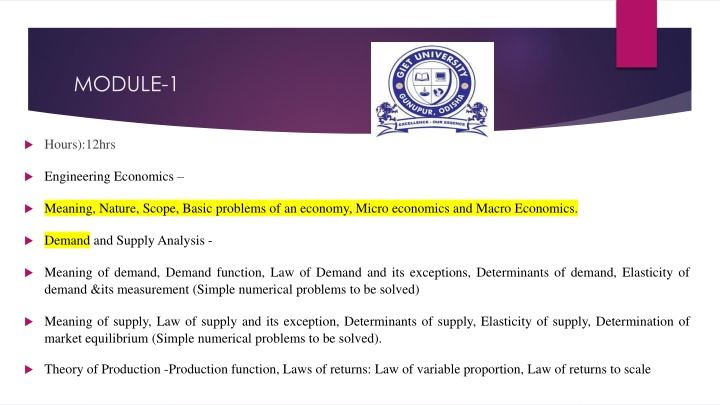
Engineering Economics: Demand, Supply, Production & Efficiency
Explore the fundamentals of engineering economics including demand and supply analysis, production theories, and efficiency concepts. Delve into the economic consequences of engineering decisions and the correlation between physical and economic environments.
Download Presentation

Please find below an Image/Link to download the presentation.
The content on the website is provided AS IS for your information and personal use only. It may not be sold, licensed, or shared on other websites without obtaining consent from the author. If you encounter any issues during the download, it is possible that the publisher has removed the file from their server.
You are allowed to download the files provided on this website for personal or commercial use, subject to the condition that they are used lawfully. All files are the property of their respective owners.
The content on the website is provided AS IS for your information and personal use only. It may not be sold, licensed, or shared on other websites without obtaining consent from the author.
E N D
Presentation Transcript
MODULE-1 Hours):12hrs Engineering Economics Meaning, Nature, Scope, Basic problems of an economy, Micro economics and Macro Economics. Demand and SupplyAnalysis - Meaning of demand, Demand function, Law of Demand and its exceptions, Determinants of demand, Elasticity of demand &its measurement (Simple numerical problems to be solved) Meaning of supply, Law of supply and its exception, Determinants of supply, Elasticity of supply, Determination of market equilibrium (Simple numerical problems to be solved). Theory of Production -Production function, Laws of returns: Law of variable proportion, Law of returns to scale
Introduction Engineering economy, the analysis of the economic consequences of engineering decisions, was originated by A. M. Wellington in his The Economic Theory of Railway Location, published in 1887. Eugene L. Grant could be called as the father of engineering economics. Engineering is the branch of science and technology deals with the application of science and math to solve problems. Economics is a social science concerned with the production, distribution, and consumption of goods and services.
Image-Figure 1 : Physical and Economic Components of an Engineering System
Physical Environment : Engineers produce products and services depending on physical laws (e.g. Ohm's law; Newton's law). Physical efficiency takes the form: Physical Efficiency = System out put s/ System input s Economic Environment : Much less of a quantitative nature is known about economic environments -- this is due to economics being involved with the actions of people, and the structure of organizations. Satisfaction of the physical and economic environments is linked through production and construction processes. Engineers need to manipulate systems to achieve a balance in attributes in both the physical and economic environments, and within the bounds of limited resources.
Economic (efficiency ) = " High-efficiency"? There are two kinds of efficiency that engineers must be concerned with. The first is physical efficiency, which takes the form: Physical Efficiency = System out put s/ System input s Economy efficiency= System Worth(benefit)/ System Cost
Meaning of Engineering Economics Meaning of Engineering Economics: Engineering is the profession in which knowledge of the mathematical and natural sciences gained by study experience and practice is applied with judgment to develop ways to utilize economically the material and forces of nature for the benefit of mankind. Engineering Economics is a subject of vital importance to Engineers. This subject helps one understand the need for the knowledge of Economics for being an effective manager and decision maker. Natural resources (from which we must build things) are becoming more scarce and more expensive. We are much more aware of negative side-effects of engineering innovations (such as air pollution from automobiles) than ever before. The Economics theories are used to take decisions related to uncertain and changing business environment. Economics theories deal with the principles of demand, pricing, cost, production, competition, trade cycles, and national income and so on.
As the design and manufacturing process become more complex, the engineer is making decisions that involve money more than ever before. The competent and successful engineer at present must have an improved understanding of the principles of economics. The engineering economics is concerned the systematic evaluation of the benefits and costs of projects involving engineering design and analysis. Engineers are planners and builders. They are also problem solvers, managers and decision makers. In the beginning of the 20thcentury, engineers were mainly concerned with the design, construction, operation of machines structures and processes. Apart from the conventional work, now engineers are expected not only to create novel technological solutions but also to make skillful financial analysis of the effects of implementation.
Definition Engineering Economics refers to those aspects of economics and its tools of analysis most relevant to the Engineer s decision making process . The Accreditation Board for Engineering and Technology (ABET) states that engineering "is the profession in which a knowledge of the mathematical and natural sciences gained by study, experience, and practice is applied with judgment to develop ways to utilize, economically, the materials and forces of nature for the benefit of mankind . Engineering Economics is the discipline, which involves with the application of economic principles to the engineering problems in order to take economic decisions towards minimizing costs and maximizing benefits to mankind or the business organization.
Nature 1. Engineering Economics is closely aligned with Conventional Micro-Economics. 2. Engineering Economics is devoted to the problem solving and decision making at the operations level. 3. Engineering Economics can lead to sub-optimisation of conditions in which a solution satisfies tactical objectives at the expense of strategic effectiveness. 4. Engineering Economics is useful to identify alternative uses of limited resources and to select the preferred course of action. Engineering Economics is pragmatic in nature. It removes complicated abstract issues of economic theory. 6. Engineering Economics mainly uses the body of economic concepts and principles. 7. Engineering Economics integrates economic theory with engineering practice.
Scope Scope of Engineering Economics: The scope of engineering economics is too broad. The topics which are covered under this heading are: Elementary economic analysis Micro economics, Macro economics Cash flow techniques Interest rate and its calculations Economic feasibility of engineering under-takings Time value of money Depreciation analysis Replacement analysis
Economic life Evaluation of public-private projects Investment decisions Make or buy decisions Basis for comparing engineering alternatives Rate of return like pay-back period analysis Sensitivity analysis Financial evaluation Supply & demand analysis, social cost estimation, demand forecasting, inventory control, price and output determination under different market situations, etc
Importance of Engineering Economics: Engineering economics is an essential tool in an organization as it helps in: Financial planning and successful promotion of an enterprise. i) Acquisition of funds as and when required at the minimum possible cost. ii) iii) Proper use and allocation of funds or resources. Making sound financial decisions. iv) Improving the profitability through financial control. v) Increasing the wealth(capital) of the investors there by increases of the wealth of the nation. vi) vii) Promotion and mobilization of individual and corporate savings. viii) Maintaining price stability and full employment of the resources etc.
Principles & Engineering Economics: The foundation of Engineering Economics is based on 7 principles: Principle 1:-Develop the alternative The decision is among alternatives. The viable alternatives need to be identified and then defined for subsequent analysis. (Problem recognition, definition, and evaluation). Principle 2:-Focus on the differences Only the difference in expected future outcomes among the alternatives is relevant to their comparison and should be considered when making the decision. One should be indifferent to the alternatives and make decision on the basis of random selection.(Development of feasible alternatives). Principle 3:-Use a consistent viewpoint The prospective outcomes of the alternatives economic and other should be consistently developed from a defined view point (Prospective). It is used consistently on the description, analysis & comparison of the alternative.
Cont.. Principle 4:-Use a common unit of measurement Using a common unit of measurement to explain as many of the prospective outcomes as possible will make easier the analysis and comparison of alternatives. Principle 5:-Consider all relevant criteria Selection of a preferred alternative (Decision making) requires the use of a criterion or several criterion. Principle 6:- Make uncertainty explicit Uncertainty is inherent in estimating the course of a action & the future outcomes of the alternatives recognized in their analyses and comparison. Principle 7:-Reconsider your decision Improved decision making results from a adoptive process to the extent practicable, the initial projected outcomes of the selected alternative should be subsequently compared with actual results achieved. (Performance monitoring & post evaluation results con side ration).
Basic problems of an economy, The basic problems of economic Sometimes called the basic or central economic problem state that an economy's limited resources are insufficient to satisfy all human wants and needs. It assumes that human wants are unlimited, but the means to satisfy human wants are scarce. Economic having the three basic problems which arises in the form of questions. 1)What to produce? This problem involves selection of goods and services to be produced and the quantity to be produced of each selected commodity. Every economy has limited resources and thus, cannot produce all the goods. More of one good or service usually means less of others. on the basis of the importance of various goods, an economy has to decide which goods should be produced and in what quantities. This is a problem of allocation of resources among different goods. The problem of What to produce has two aspects: (i) What possible commodities to produce: (ii) How much to produce:
Cont.. 2) How to produce? This problem refers to selection of technique to be used for production of goods and services. A good can be produced using different techniques of production. By technique , we mean which particular combination of inputs to Generally, techniques are classified as: Labor intensive techniques (LIT) and Capital intensive techniques(CIT). i. In Labor intensive technique, more labor and less capital (in the form of machines, etc.) is used. ii. In Capital intensive technique, there is more capital and less labor utilization.
Cont 3) For whom to produce? This problem refers to selection of the category of people who will ultimately consume the goods, i.e. whether to produce goods for more poor and less rich or more rich and less poor. Since resources are scarce in every economy, no society can satisfy all the wants of its people. Thus, a problem of choice arises. Goods are produced for those people who have the paying capacity. The capacity of people to pay for goods depends upon their level of income. It means, this problem is concerned with distribution of income among the factors of production (land, labour, capital and organization), who contribute in the production process. The problem can be categorized under two main heads: (i) Personal Distribution: It means how national income of an economy is distributed among different groups of people. (ii) Functional Distribution: It involves deciding the share of different Sectors of Production in the total national product of the country. Guiding Principle of For whom to Produce : Ensure that urgent wants of each productive factor are fulfilled to the maximum possible extent.
Micro economics and Macro Economics. Micro economics and macro economics Economic analysis is of two types: MICRO & MACRO Analysis. In recent years the subject matter of economics has been made to fall into two major branches (I) Micro economics which is the study of the economic actions of individuals & well-defined groups of individuals, and (II) Macro economics which is the study of broad aggregates such as total employment and national income.
FEATURES OF MICRO ECONOMICS: Supply and demand in individual markets Individual consumer behavior. e.g. consumer choice theory Individual labor markets e.g. demand for labor, wage determination FEATURES OF MACRO ECONOMICS: Monetary / fiscal policy. e.g. what effect does interest rates have on the whole economy? Reasons for inflation, and unemployment Economic growth International trade and globalization
DISTINGTION BETWEEN MICRO ECONOMICS AND MACRO ECONOMICS Basis Micro Macro On the basis of Definition Micro economics is the study of Particular firm, particular household, Individual price, wage, income, industry& particular commodity. Macro economics is the study of economics system as a whole. It deals with totals or aggregates -national income, output & employment, total consumption, saving, investment & the general level of price. The objective of macro economics is the study of problems, policies of principles relating to full employment of resources & growth of resources On the basis of Objectives The objective of micro economics is to study the principles, problems & policies concerning the optimum allocation of resources. On the basis of The subject matter of micro economics deals with the determination of price, The subject matter of macro economics is full-employment, national income, general

